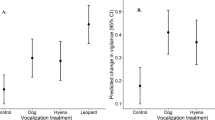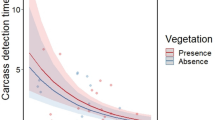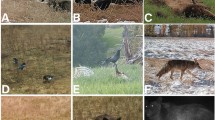Abstract
The brown recluse spider (Loxosceles reclusa) is a threat to humans and establishes huge populations in urban habitats throughout central North America1,2 — more than 2,000 of these spiders were recorded in a single house in Kansas3. What do these spiders eat in order to build and maintain such numbers? Here I combine laboratory prey-choice experiments with observations of the behaviour of L. reclusa in houses to show that this spider prefers dead, scavenged prey over live prey. This finding may explain how immense populations of these spiders can flourish even in adverse conditions.
Similar content being viewed by others
Main
All spiders consume live prey and they have evolved a diverse array of adaptations to enhance its detection and capture. Some spiders also supplement their diets with unusual food sources such as pollen4, nectar5 and insect eggs6. However, spiders would not be expected to prefer dead prey, given the stimulus of catching live prey that results from their extreme sensitivity to even the slightest movement of their victim.
Bites from brown recluse spiders (Fig. 1) can constitute a medical emergency in humans, inflicting slow-healing necrotic wounds and extensive tissue damage1,2. The same powerful paralysing venom that causes these effects in humans also allows the spider to immobilize its prey and avoid being injured itself7. Unlike most wandering spiders, which use vision, stealth and strength to capture prey, L. reclusa attacks, retreats and then returns to feed at its convenience7; it has relatively poor vision7 and does not readily respond to substrate or airborne vibration.
I investigated the predatory behaviour of L. reclusa in 71 homes in Kansas and did not see spiders catching live prey — indeed, the spiders actually fled from potential prey. However, I witnessed the spiders locating and consuming dead prey, without prior attack, in more than 25 houses.
For the prey-choice experiments, I placed adult male and female L. reclusa (n = 147) into individual plastic boxes (12 × 17 × 6 cm) and fed them a variety of prey, both dead and alive, once a week, and then starved them for two weeks. The spiders were subsequently presented with equally sized live and dead prey (dead prey was killed by freezing at −80 °C). Spiders were kept in the dark and observed under low light every hour for evidence of prey choice, which was verified by fang penetration and feeding for 5 min or longer.
In these experiments, 81.4% of L. reclusa chose dead over live waxmoth larvae (Achroia grisella; n = 59), 75.6% chose dead over live domestic crickets (Acheta domestica; n = 41) and 97.6% chose dead over live yellow mealworm larvae (Tenebrio molitor; n = 41). Overall, spiders chose dead prey in 84.4% of trials (χ2 = 72, P << 0.001), indicating a clear preference for scavenging dead prey.
To test the effects on the spiders of eating dead rather than live prey, I used three groups of ten spiders that had been respectively given: old dead crickets that had been envenomated and partially digested by other L. reclusa two weeks previously; German cockroaches (Blattella germanica) that had been dead for at least a month; and B. germanica that had been killed 24 h earlier with Cessco-5E insecticide (0.5% pyrethrin). All spiders consumed the prey within 24 h of its being introduced, and showed their resilience in that no obvious negative effect was manifest over the ensuing 10 months, during which a regular feeding regime was followed.
The feeding preferences that I observed in urban habitats are consistent with my findings with captive spiders, indicating that L. reclusa actively searches for dead prey and ignores live prey. Spiders will even remain motionless and allow their prey to walk over them without attacking it, such is the extent to which they prefer dead prey. In five T. molitor trials, spiders attacked and killed live prey but did not eat it, yet consumed prey killed by freezing. Capture of live prey (15.6%) was often the result of prey walking into spiders rather than of active hunting.
The sequence of predatory behaviour shown by L. reclusa (attack, retreat and feed later) means that prey may escape before it is relocated. Spiders sometimes leave partially eaten carcasses that other spiders subsequently find and consume. It is likely that dead prey provides an easily accessible source of nutrition without incurring the additional costs or risks associated with attacking and manipulating live prey.
L. reclusa is an opportunistic feeder rather than an obligate predator or obligate scavenger, but it prefers dead over live prey. In an environment such as a house, opportunists and scavengers have an advantage over more selective predators because their feeding requirements are more easily met8. Insects are attracted to houses by light, food and shelter, as well as for other unknown reasons, but they can easily die there from starvation, desiccation, overexertion, pesticide exposure or other causes. I conclude that scavenging contributes significantly to the diet of L. reclusa and may be important for the survival of this species in natural habitats, as well as being beneficial to them when they are in close proximity to humans.
References
Atkins, J. A., Curtis, W. W., Sodeman, W. W. & Flynn, J. E. Am. J. Trop. Med. Hyg. 7, 165–184 (1958).
Gertsch, W. J. & Ennik, F. Bull. Am. Mus. Nat. Hist. 175, 264–360 (1983).
Vetter, R. & Barger, D. J. Med. Entomol. 39, 948–951 (2002).
Smith, R. B. & Mommsen, T. P. Science 226, 1330 (1984).
Pollard, S. D. Nat. Hist. 102, 58 (1993).
Jackson, R. R. & Blest, A. D. J. Zool. 196, 255–293 (1982).
Hite, J. M., Gladney, W. J., Lancaster, J. L. Jr & Whiticomb, W. H. Univ. Arkansas Agric. Exp. Stn Bull. 711, 1–26 (1966).
Knost, S. J. & Rovner, J. S. Am. Mid. Nat. 93, 239–244 (1975).
Author information
Authors and Affiliations
Ethics declarations
Competing interests
The author declares no competing financial interests.
Rights and permissions
About this article
Cite this article
Sandidge, J. Scavenging by brown recluse spiders. Nature 426, 30 (2003). https://doi.org/10.1038/426030a
Issue Date:
DOI: https://doi.org/10.1038/426030a
This article is cited by
-
Synanthropic spiders, including the global invasive noble false widow Steatoda nobilis, are reservoirs for medically important and antibiotic resistant bacteria
Scientific Reports (2020)
-
The Predation Strategy of the Recluse Spider Loxosceles rufipes (Lucas, 1834) against four Prey Species
Journal of Insect Behavior (2016)
-
The Importance of Pesticide Exposure Duration and Mode on the Foraging of an Agricultural Pest Predator
Bulletin of Environmental Contamination and Toxicology (2015)
Comments
By submitting a comment you agree to abide by our Terms and Community Guidelines. If you find something abusive or that does not comply with our terms or guidelines please flag it as inappropriate.




